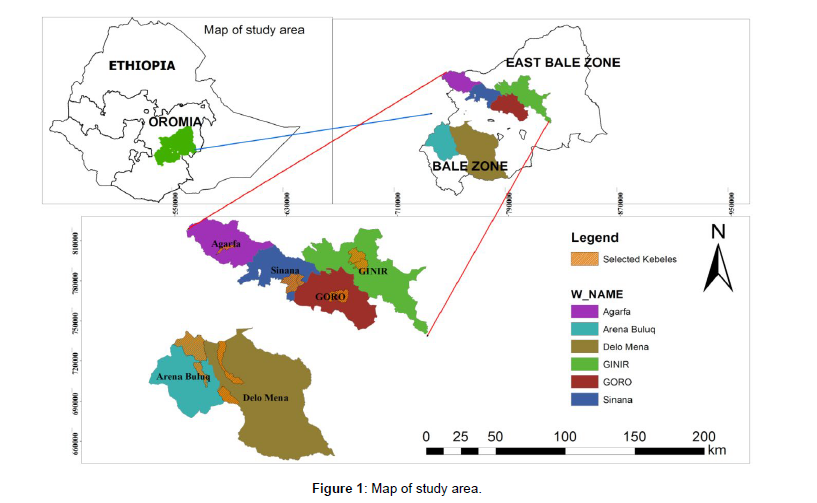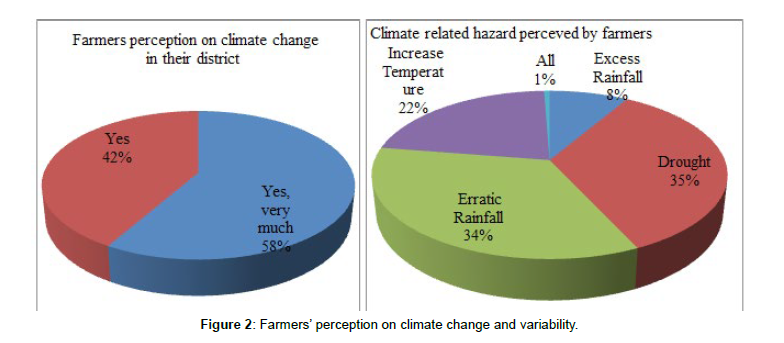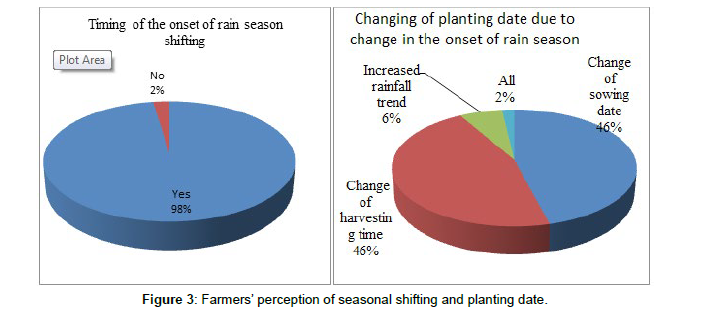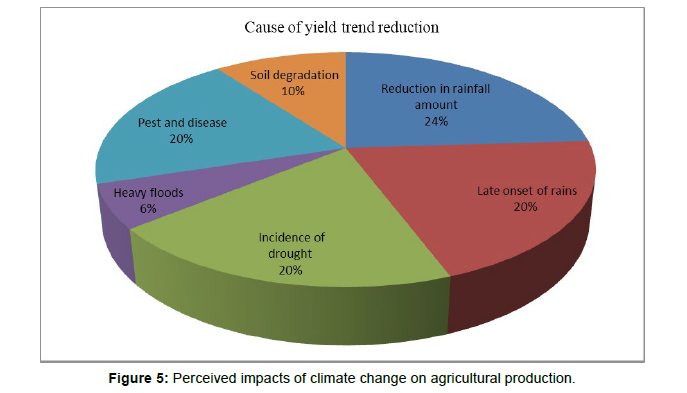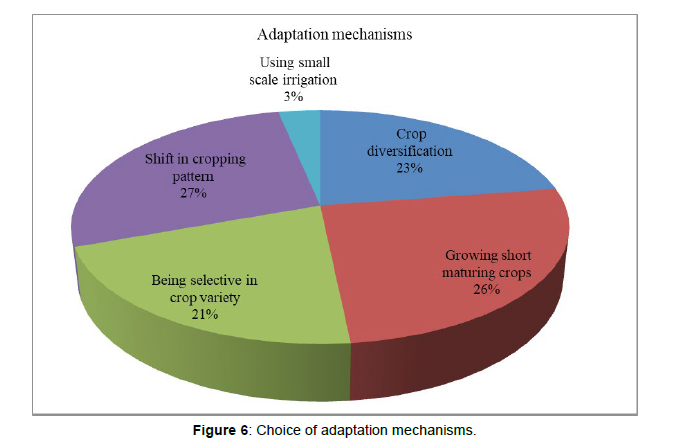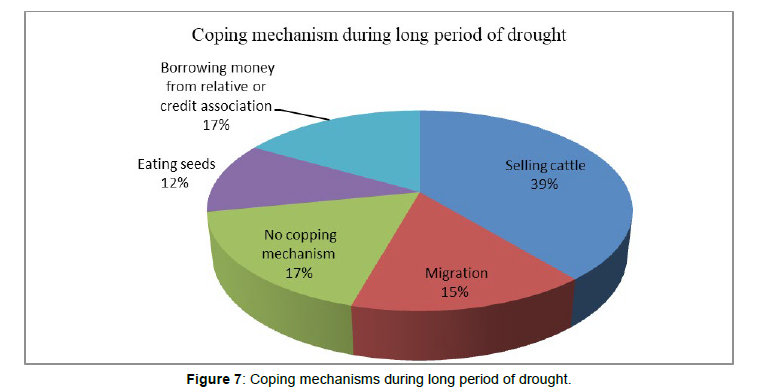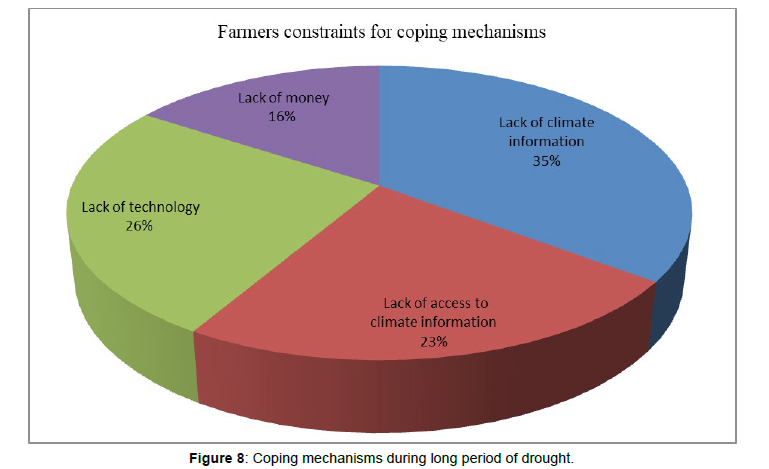Assessing the Farmers' Perceptions and Adaptations Strategies to Climate Change and Variability in Bale and East Bale Zones South-eastern Ethiopia
Received: 03-Jul-2023 / Manuscript No. EPCC-23-93202 / Editor assigned: 05-Jul-2023 / PreQC No. EPCC-23-93202 (PQ) / Reviewed: 19-Jul-2023 / QC No. EPCC-23-93202 / Revised: 22-Jul-2023 / Manuscript No. EPCC-23-93202 (R) / Published Date: 29-Jul-2023 DOI: 10.4172/2573-458X.1000342
Abstract
This study was aimed to compare farmers’ perception and adaptation strategies to climate change and variability, its determinants and impacts in East Bale and Bale zone. The study aims to assess farmers’ perception on climate change and variability with their adaptation strategies, to examine the constraints of adapting to climate change/variability and to identify best practices for adaptation measures that farmers are using currently. Purposive and probability sampling method were used to select households. Multi-stage purposive sampling technique was used to select climate related risk kebeles and discussants for the assessment. The station nearby kebeles was selected purposively from highland, midland and lowland districts. Structured and semi-structured questionnaires were distributed for these sample households for interview. Also, factors that influence farmer’s perception of climate change and variability were used for the study areas. Total 58% of farmers interviewed during the survey perceived very much significant climate change in the study areas. About 98% of the farmers perceived planting date was shifted from historically known, whilst 2% was perceived no change in planting date from historical known.
Keywords
Climate change; Perception; Adaptation; Risk
Introduction
Climate change is one of the most immediate and complex challenges for society and economies [1]. Climate change is likely to adversely affect the lives of poor and rural African farmers,potentially undermining food security and socio-economic development if no appropriate measures are taken [2]. Climate change now-a-days is recognized as one of the most challenging and complex problem facing the agricultural development globally. The production of crop yield in Africa will decrease up 50% due to climate change . Ethiopian economy is driven by agriculture despite the issue of high rainfall variability that leads to frequent drought and severe land degradation (EPCC 2015). These effects vary from region to region in particular the risk in Ethiopia becomes more severe since more than 85% of the country’s economy dependent on rainfed agriculture. Farmers’ perception plays a big role for successful implementation of adaptation strategies to mitigate climate change impacts as agricultural practices concerned. Adaptation strategies can effectively help rural households to prevent or minimize the adverse impacts of climate change as well as enable them to take advantage of the opportunities that they generate.
Farm adaptation strategies can include crop diversification, adjustment of cropping calendars, farmers’ adoption of more droughtresilient crops. Farmer’s perceptions of climate change are related to historical trends in climate. The analysis of perception of farmers on climate variability and change of farmers showed a decline in rainfall amount, increased temperature, and shift in onset dates of rainfall, early withdrawal of rains and frequent drought occurrence. Based on station long-term rainfall data analysis, however, neither annual nor seasonal rainfall trend were showed reduction in amount which contradicts with the farmers perception. On the other hand, the farmers’ perception of increasing or decreasing temperature was identified and in accordance with the trend of record temperature data. The farmers attributed may the cause of climate variability and change mainly to factors such as punishment from God, deforestation and increasing human population. The farmers were awarded as the impact of climate changes occurring in their area in the last decades. The farmers were indicated decreasing/ increasing diversity of cultivated mixed crops-livestock farming systems, changes in farming practices and reduction in croplivestock yields due to changes in climate patterns. Climate variation mainly affects Agricultural production dependent community like agro-pastoralist and pastoralist due to their economy drive by weather condition. More than 80% of Ethiopians live in rural areas as farmers and pastoralists. They rely primarily on crop and livestock production for their livelihoods. This is a fragile existence that lacks basic capacity to provide livelihood security. Having enough seed for next year’s planting, being able graze their livestock, and to feed and clothe their families – everything depends on what the weather brings. This dependence makes them highly sensitive to climate change. Rains are unpredictable and erratic. Temperatures are increasing and rainfall patterns changing unpredictably. Besides the direct effects, climate change also presents the necessity and opportunity to switch to a new, sustainable development model. The findings of this study was used as inputs for researchers, Extension experts and decision makers enable to select suitable crops/varieties, enable policy makers to get prepared to the negative impacts on crop –livestock production and as reference/baseline for further studies.
Hence, this study was expected to fill the knowledge gap on the understanding of impact of past and future climate in Bale zone in selected districts, on crop-livestock production and enhancing the case of climate information to increase production and productivities under changing and variable climate. Based on the skill of the designed assessment the local development partners as well as farmers were utilized the information as primary input in designing early stage protective measure and minimize the adverse effect of climaterelated risks on mixed crop-livestock production. Because there has been no enough research on these factors under climate change and adaptation on mixed crop-livestock production in Bale zone, this study could significantly contributed to the knowledge base of the climate change adaptation research for development. Thus, the present study was initiated with objectives, to assess farmers’ perception on climate change and variability with their adaptation strategies, to examine the constraints of adapting to climate change/variability and to identify best practices for adaptation measures that farmers are using currently [3,4].
Materials and Methods
The study areas located between 6028’ N to 7030’N and 39075’E to 40080’ E including different agro-ecologies (highlands, midlands and lowlands) from East Bale and Bale Zones. The study was carried out with in six (6) selected districts such as Agarfa, Sinana, Goro, Ginnir, Dello mena and Harena Buluk districts for intervention. From highlands districts, Sinana (Jafara and Amalama) and Agarfa (Mokonna chafa and Ilani) were included the survey. Similarity, from midland districts Goro (Nere Nagaya and Chafa) and Ginnir (Ebisa and Akasha) also included, while from lowland Dallo menna (Melka Amana and Wabaro) and Harenna Buluk (Hawo and Sodu Walmal) were selected (Figure 1).
Data type, sources and methods of collection
The household survey was carried out using a standard structured questionnaire for data collection. The survey assessed perceptions of extreme weather events, changes in rainfall, temperature for the last three decades, how changes in climate have affected their agricultural practices and the changes made by farmers on their crop production because of climate changes and variability impacts. Purposive sampling techniques were used in the selection of study site and sample households. From highland districts Agarfa and Sinana were selected and from midland districts Ginnir and Goro were selected while from lowland districts Dello menna and Harena Buluk were selected to cover different agro-ecologies in study areas. The criteria considered for the selection of study areas were: representativeness, prevalence of the problem, availability of relevant data and proximity to meteorology station. Most of the people in the area are engaged in crop production in highland districts while mixed agricultures (and livestock production) are practiced in midland districts and lowland districts. Moreover, lowland districts are agro-pastoralist. Crop production is entirely rain fed practiced and farmers are severe with climate change and variability. To ascertain if farmers’ perceptions of climate change and variability correspond to actual long term climatic records data and downloaded climatic data for the selected stations of East Bale and Bale were analyzed and compared with the survey results[5].
Analytical framework of the study
The present study focuses on farmer’s perception of climate change and climate variability for identifying factors affecting farmers’ perception of adaptation strategies to climate related impacts. Subsequently, the selected kebeles in the districts were visited and discussions held with their respective Development Agents (DAs) and kebele leaders. The guidance were given for DAs to select farmers composed of different age categories from both male-headed and female-headed households for Participatory Rural Appraisal (PRA) discussions.
Sampling methods
Survey design and data collection: Prior to actual assessment work, a agroforestry researcher’s team consisted from Agrometeorology were established at Sinana Agricultural Research Center (SARC) for this study. For this study, both purposive and probability sampling were employed. Accordingly, a multi-stage purposive sampling technique was used to select climate related risk kebeles and discussants for the assessment. The station nearby kebeles was selected purposively from selected districts. Probability (simple) random sampling method was employed to select one kebele from each of the districts. Subsequently, the selected kebeles in the districts were visited and discussions held with their respective Development Agents (DAs) and kebele leaders. At the first stage, out of 18 districts in Bale and East Bale zones, Agarfa, Sinana, Goro, Ginnir, Dallo menna and Harena Buluk Districts were purposively selected due to the fact that the District s are frequently susceptible to climate related problems. In the second stage, 12 Kebeles were selected from the 3 agro-ecologies, using probability proportional to size. At the third stage, in order to know perceptions to climate variability and change between gender groups‟ households in the selected kebeles were categorized in to male and female headed households. Then, sample households were selected using simple random sampling (SRS) with probability proportional to size technique. Simplified formula provided by Yamane (Yilma, 2005) is used to determine the required sample size at 95% confidence level, 5% degree of variability and 8% level of precision. Accordingly, 160 sample households were selected for inclusion in the analysis [6-8].
Sample size and sampling procedure
For the quantitative survey, three stage sampling procedures were employed in order to select sample farmers. In the first stage, in order to correlate farmers’ perceptions with observed weather data, these districts with long term meteorological data records were purposively selected. In the second stage, for the same reason, two peasant associations near to the meteorological station in each district was selected purposively. Finally, a total of farm households were sampled randomly using probability proportional to the sizes (PPS) of the population of each district and peasant association from which sample households to be drawn. To select sample households from the selected peasant associations, list of household heads were used formula for calculating a sample size was described as follows:-

Where N is population size, n is the sample size and e is the level of precision (Belay, 2012; Getachew et al., 2014; Yemane, 2001)
Survey data analysis
Survey data were analyzed using the statistical package for social sciences (SPSS) to analysis descriptive statistical tools such as, mean, percentages, frequencies and standard deviations were used to summarize and categorize the information gathered. Climate data were analyzed using drought indices calculator (DrinC) tool to indicate drought frequency of the areas. So, Standardized Precipitation Index (SPI) was computed for all stations [9-11].
Results and Discussion
Farmer’s perception on climate change
Characteristics of respondents: During the survey was conducted, about 295 respondents included in the survey, 90.2% were male and the rest 9.8% were female. The ages of household head respondents were ranges from 20 to 80 years old. Around 36.3% of the respondents were above 55 years old and about 63.7% were below 54 years. From the total respondents around 99.5% were engaged their livelihood with agriculture practices whereas only about 0.5% respondent depend on both agricultural and local trade.
Community response and perception of changes in rainfall and temperature
The assessment of smallholder farmers’ perception of climate change, level of vulnerability and adaptation adopted in the Bale and East Bale Zones suggested that most of the farmers were aware of the climatic changes happening in the area and were already adjusting their farm practices to cope with the impact. Of the farmers interviewed, 42 % perceived climate change and 58% also perceived significant change in the study areas. Climate changes are observed in different climate parameters fluctuation like temperature and rainfall. Up to 35 % of the total respondents perceived drought in the areas. Although 34% of the total respondents perceived erratic rainfall, up to 22% were perceived in increase temperature while, 8% were contrary to this view since they perceived excess rainfall in the study areas (Figure 2).
Farmers’ perception of seasonal shifting and planting date
About 98% of the farmers perceived planting date was shifted from historically known in the study areas, whilst 2% was perceived no change in planting date from historical known. Additionally, due to seasonal shifting 46% of farmers were perceived change of harvesting time, 46% also perceived change of sowing date in the areas (Figure 3).
Farmers’ perception changing of climate impacts
Farmers’ perceived impacts of climate changes concerning at different stage plant during cropping season. 36% of respondents were perceived more damage at vegetative stage if climate hazards were occurred. Similarly, About 35% respondents were perceived more climate impacts expected at flowering stage. Climate change impacts were perceived in different ways like erratic rainfall, reduction of rainfall, increase temperature, early withdrawal for rainfall, late start of rainfall, increased frequency of drought, increased frequency of flood and etc. About 24% respondents were perceived climate change impacts in reduction of rainfall amount in the study areas (Figure 4).
Perceived impacts of climate change on agricultural production
The study results revealed decline in crop yield, increase in pest and disease, reduced seedling, delayed in seedling and delayed in maturity as the major impacts of climate change and variability on crop production in Bale and East Bale Zones. The dominant crops for subsistence and cash for the communities in all agro-ecologies like wheat beans, peas and potatoes and barley highlands areas, while horticultural crops are very common in mid-lands and low-lands districts. However, crop yields in all areas is on a declining due to climate change, land degradation, pests and diseases, high cost of inputs and decreasing land sizes. The results revealed that the farmers perceived various impacts of climate change: About 24% of respondents were perceived reduction in rainfall amount over the last 20 years. The types of soil degradation in the study area were include 10%, Pest and disease 20%, late onset rainfall 20% , incidence of drought 20% and heavy floods were 6%, while major one was 24% according to respondents perception (Figure 5).
Choice of adaptation mechanisms
Changing planting dates, soil conservation and using different crop varieties were the major methods. The other methods included planting trees, prayers and irrigation, with water harvesting being the method least adapted despite its numerous benefits. When asked if these farmers had introduced adaptation methods due to the perceived changes in climate, the majority, farming 27% of the total population, practiced shifting in cropping pattern, 26% of respondents were practiced growing short maturing crops. For the study areas, other adaptation mechanisms were practiced like crop diversification and selected varieties which perceived by 23% and 21% of total interviewed respectively, while the remaining 3% had using small scale irrigation (Figure 6).
Farmers had coping mechanisms during long period of drought to sustain their life. Some mechanisms were responded by farmers during the survey was conducted in the study areas. 39% of respondents were perceived selling cattle during long period of drought were occurred. For some districts about 15% of farmers perceived migration with their livestock during drought was occurred (Figure 7).
Farmer’s constraints to adaptation and needs
Most of the farmers in Bale and East Bale Zones are aware of the impact of climate change, especially changes in temperature and precipitation, but farmers had lack of climate information. The findings from this study revealed that smallholder farmers are vulnerable to the impacts of climate change, and this impact not only affects their livelihood but also reduces their assurance of food security, as the majority of these farmers consume and sell their produce. Climate change in terms of precipitation and temperature has significantly affected farmers’ crop production, as survey data indicated 35% of farmers had lack of climate information for their agricultural practiced, with only 23% respondents had lack of access to climate information during cropping season. Additionally, about 26% were perceived had lack of technology for their agricultural practicing. This limitation tends to aggravate farmers’ vulnerability (Figure 8).
Conclusion
The results show that the more than 98% of the farmers have perceived climate changes, especially in rainfall and temperature which experienced the effects of a changing climate over a period of three decades. That is, extended dry periods and declining precipitation are more frequent across the agro-ecologies in the districts. As a result, both livestock and crop production by smallholder farmers have already been adversely affected. The farmers are trying to adapt through the use of improved agricultural practices like crop diversification, improved crop varieties, and use of agricultural inputs like fertilizers and pesticides. Farmers’ capacity to choose effective adaptation options is influenced by household lack of climate information, lack of access to climate information, lack of technology and lack of money for their agricultural practices. This implies the need to support the indigenous adaptation strategies of the smallholder farmers with a wide range of institutional, policy, and technology support, some of it targeted on smaller, poorer or female-headed households. As the rainy seasons are recently becoming more and more unpredictable and uncertain, depending on rain-fed agriculture in the area is less unlikely and hence policy driven actions to provide irrigation facilities based on both ground and surface water are vital. Moreover, creating opportunities for non-farm income sources is important as this helps them to engage in those activities that are less sensitive to climate change. Furthermore, providing climate change information, extension services, and providing new varieties which tolerate drought conditions are crucial. Farmers’ perception, when in line with the actual changes in climate patterns, may guarantee the effectiveness of specific adaptation strategies, such as agricultural calendar adjustments, changes in the timing of fallow periods, the use of drought-tolerant or native varieties, and pest and invasive species control. Climate change awareness can be enhanced by policies aimed at strengthening weather and climate information systems as well as knowledge dissemination. Therefore, including these activities in the existing formal extension channels of the Agro meteorologist and other line disciples will be useful to farmers.
Acknowledgment
The author thanks Oromia Agricultural Research Institute for their financial support and Sinana Agricultural Research Center (SARC) for giving me all facilities during this activity was done.
References
- Tesfahunegn F, Gebreyesus B, Kirubel M, Abadi T (2016) Farmer’s perception on causes, indicators and determinants of climate change in Northern Ethiopia: Implication for developing adaptation strategies. Applied Geography 73: 1-12.
- Gedefaw M, Girma A, Denghua Y, Hao W, Agitew G (2018) Farmer's Perceptions and Adaptation Strategies to Climate Change, Its Determinants and Impacts in Ethiopia: Evidence from Qwara District. J Earth Sci Clim Change 9: 481.
- Yayeh D, Walter L (2017) Farmer’s perceptions of climate variability and its adverse impacts on crop and livestock production in Ethiopia. Journal of Arid Environments 140: 20-28.
- Bisrat K, Gizaw M, Gerrit H (2017) Climate risk management climate change and population growth impacts on surface water supply and demand of Addis Ababa, Ethiopia. 8: 1.
- https://www.researchgate.net/publication/283514151_Ethiopian_Panel_on_Climate_Change_First_Assessment_Report_Agriculture_and_Food_Security_Working_Group_II
- Hameso S (2018) Farmers and policy-makers’ perceptions of climate change in Ethiopia. Climate and Development 10: 347–359.
- Barrucand MG, Giraldo Vieira C, Canziani PO (2017) Climate change and its impacts: Perception and adaptation in rural areas of Manizales, Colombia. Climate and Development, 9: 415-427.
- Ringler C, Bryan E, Hassan RM, Alemu T, Hillesland M (2011) How can African agriculture adapt to climate change? Insights from Ethiopia and South Africa. Research brief series, International Food Policy Research Institute (IFPRI), Washington, DC.
- Swe L M M, Shrestha R P, Ebbers T, Jourdain D (2015) Farmers’ perception of and adaptation to climatechange impacts in the dry zone of Myanmar. Climate and Development, 7: 437-453.
- Arndt C, Chinowsky P, Robinson S, Strzepek K Tarp F, Thurlow J (2012) Economic development under climate change. Review of Development Economics, 16: 369–377.
- Abirham Cherinet, Zenebe Mekonnen (2019) Comparing Farmers’ Perception of Climate Change and Variability with Historical Climate Data: The Case of Ensaro District, Ethiopia. Int J Environ Sci Nat Res. 17: 555966.
Citation: Tufa ZD (2023) Assessing the Farmers’ Perceptions and Adaptations Strategies to Climate Change and Variability in Bale and East Bale Zones Southeastern Ethiopia. Environ Pollut Climate Change 7: 342. DOI: 10.4172/2573-458X.1000342
Copyright: © 2023 Tufa ZD. This is an open-access article distributed under the terms of the Creative Commons Attribution License, which permits unrestricted use, distribution, and reproduction in any medium, provided the original author and source are credited.
Select your language of interest to view the total content in your interested language
Share This Article
Recommended Journals
Open Access Journals
Article Tools
Article Usage
- Total views: 1807
- [From(publication date): 0-2023 - Dec 16, 2025]
- Breakdown by view type
- HTML page views: 1450
- PDF downloads: 357

